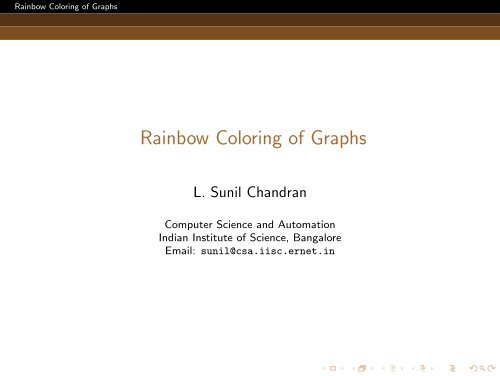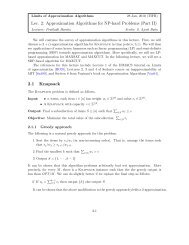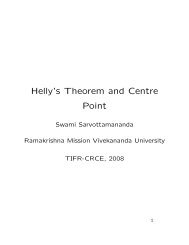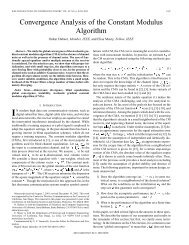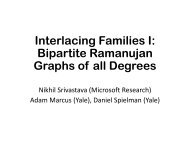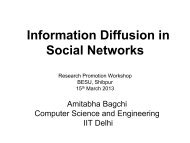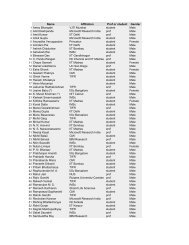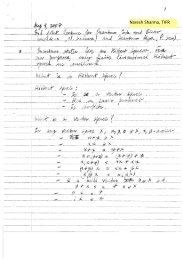Rainbow Coloring of Graphs - Microsoft Research
Rainbow Coloring of Graphs - Microsoft Research
Rainbow Coloring of Graphs - Microsoft Research
Create successful ePaper yourself
Turn your PDF publications into a flip-book with our unique Google optimized e-Paper software.
<strong>Rainbow</strong> <strong>Coloring</strong> <strong>of</strong> <strong>Graphs</strong><strong>Rainbow</strong> <strong>Coloring</strong> <strong>of</strong> <strong>Graphs</strong>L. Sunil ChandranComputer Science and AutomationIndian Institute <strong>of</strong> Science, BangaloreEmail: sunil@csa.iisc.ernet.in
<strong>Rainbow</strong> <strong>Coloring</strong> <strong>of</strong> <strong>Graphs</strong>What is <strong>Rainbow</strong> <strong>Coloring</strong>?Consider an edge coloring, not necessarily proper.
<strong>Rainbow</strong> <strong>Coloring</strong> <strong>of</strong> <strong>Graphs</strong>What is <strong>Rainbow</strong> <strong>Coloring</strong>?Consider an edge coloring, not necessarily proper.A path between two vertices is a rainbow path if no two edgesin this path have the same color.
<strong>Rainbow</strong> <strong>Coloring</strong> <strong>of</strong> <strong>Graphs</strong>
<strong>Rainbow</strong> <strong>Coloring</strong> <strong>of</strong> <strong>Graphs</strong>If there is a rainbow path between every pair <strong>of</strong> vertices, thenthe coloring is called a rainbow coloring.
<strong>Rainbow</strong> <strong>Coloring</strong> <strong>of</strong> <strong>Graphs</strong>If there is a rainbow path between every pair <strong>of</strong> vertices, thenthe coloring is called a rainbow coloring.Minimum number <strong>of</strong> colors required to achieve this is calledthe rainbow connection number rc(G).
<strong>Rainbow</strong> <strong>Coloring</strong> <strong>of</strong> <strong>Graphs</strong>If there is a rainbow path between every pair <strong>of</strong> vertices, thenthe coloring is called a rainbow coloring.Minimum number <strong>of</strong> colors required to achieve this is calledthe rainbow connection number rc(G).
<strong>Rainbow</strong> <strong>Coloring</strong> <strong>of</strong> <strong>Graphs</strong>ExamplesThe complete graph K n : rc(K n ) = 1.A path on vertices, P n : rc(P n ) = n − 1.A Tree on n vertices T n : rc(T n ) = n − 1.The complete bipartite graph K n,n : rc(K n,n ) = 2.The cycle C n : rc(C n ) = ⌈n/2⌉.
<strong>Rainbow</strong> <strong>Coloring</strong> <strong>of</strong> <strong>Graphs</strong>An obvious upper bound for rc(G)Consider a spanning tree T <strong>of</strong> G.<strong>Rainbow</strong> color T, and then give any used color to other edges.This is a rainbow coloring <strong>of</strong> G using n − 1 colors. So,rc(G) ≤ n − 1.
<strong>Rainbow</strong> <strong>Coloring</strong> <strong>of</strong> <strong>Graphs</strong>The obvious lower bounds for rc(G)The diameter <strong>of</strong> G.The number <strong>of</strong> bridges in G.
<strong>Rainbow</strong> <strong>Coloring</strong> <strong>of</strong> <strong>Graphs</strong>Algorithmic QuestionComputing the rainbow connection number <strong>of</strong> an arbitrarygraph is NP-Hard. (Chakraborty et.al. 2009)It is interesting to find good approximation algorithms.
<strong>Rainbow</strong> <strong>Coloring</strong> <strong>of</strong> <strong>Graphs</strong>This presentation is based on the following two recent papers fromour group.<strong>Rainbow</strong> Connection Number and Connected Dominating Sets(L. S. Chandran, A. Das, Deepak Rajendraprasad, Nitin M.Vema)<strong>Rainbow</strong> Connection Number and Radius (M. Basavaraju, L.S. Chandran, D. Rajendraprasad, Arun Ramaswamy).
<strong>Rainbow</strong> <strong>Coloring</strong> <strong>of</strong> <strong>Graphs</strong>Previous WorkMost <strong>of</strong> the previous work in this area attempts to come up with abound for rc(G) in terms <strong>of</strong> n and the minimum degree δ.A lower bound would be 3(n − 2)/(δ + 1) − 1.Introduced by Chartrand, Johns, McKeon, Zhang, 2008.(Cairo et. al. 2008) If δ ≥ 3, then rc(G) < 5n/6.(Cairo et. al. 2008) For general δ, rc(G) ≤ c.n log δ/δ, wherec is a constant.Schiermeyer proved for δ > 3, rc(G) ≤ 3n/4 and conjecturedfor general case, rc(G) may be at most 3n/(δ + 1)when δ ≥ ǫn, for some constant ǫ, Chakraborty showed thatthere exists a large constant C such that rc(G) ≤ C.(Krivelevich and Yuster, 2010.) rc(G) ≤ 20n/δ.
<strong>Rainbow</strong> <strong>Coloring</strong> <strong>of</strong> <strong>Graphs</strong>Connected Dominating set and <strong>Rainbow</strong> coloringCan a small connected dominating set in G help to get smallvalue for rc(G) ? We may try the following intuitive approach.First get a rainbow coloring <strong>of</strong> the connected dominating set.Then color the remaining edges in such a way that for eachvertex x outside there are two disjoint rainbow colored paths(rainbow colored using different set <strong>of</strong> colors).
<strong>Rainbow</strong> <strong>Coloring</strong> <strong>of</strong> <strong>Graphs</strong>The idea <strong>of</strong> Krivelevitch and YusterFirst devides G into subgraphs G 1 and G 2 .Finds 2-step dominating sets in G 1 and G 2 .Make it a connected set D in G.From a vertex x outside D, reach D using the path in G 1 andreach back from D to x using the path in G 2 .The total colors used is rc(D) + 4.
<strong>Rainbow</strong> <strong>Coloring</strong> <strong>of</strong> <strong>Graphs</strong>Our ImprovementKrivelevitch has split the graph G into two graphs G 1 and G 2 .We will show that this is not necessary.
<strong>Rainbow</strong> <strong>Coloring</strong> <strong>of</strong> <strong>Graphs</strong>Two-way dominating setA dominating set D is called a two-way dominating set if everypendant vertex belongs to D. if G[D] is connected then it is calleda connected two-way dominating set.
<strong>Rainbow</strong> <strong>Coloring</strong> <strong>of</strong> <strong>Graphs</strong>In terms <strong>of</strong> two-way dominating setrc(G) ≤ rc(G[D]) + 3
<strong>Rainbow</strong> <strong>Coloring</strong> <strong>of</strong> <strong>Graphs</strong>The ideaLet D be the two-way dominating set. Color the edges <strong>of</strong>G[D] using rc(G[D]) = k colors.We group the vertices <strong>of</strong> V ′ = V − D into three sets X, Y , Z.Z is the set <strong>of</strong> isolated vertex in G[V ′ ]X, Y form a bipartition based on a spanning forest <strong>of</strong> theinduced subgraph on V ′ − D.
<strong>Rainbow</strong> <strong>Coloring</strong> <strong>of</strong> <strong>Graphs</strong>
<strong>Rainbow</strong> <strong>Coloring</strong> <strong>of</strong> <strong>Graphs</strong>X − D edges are given color k + 1, Y − D edges are givencolor k + 2. Exactly one edge from z to D is given colork + 1, for z ∈ Z. Edges within G[V ′ ] are colored k + 3.
<strong>Rainbow</strong> <strong>Coloring</strong> <strong>of</strong> <strong>Graphs</strong>For every connected graph G, with minimum degree δ ≥ 2,rc(G) ≤ γ c (G) + 2
<strong>Rainbow</strong> <strong>Coloring</strong> <strong>of</strong> <strong>Graphs</strong>lower and upper bounds for the some graph classes.Interval graphs: diam(G) ≤ rc(G) ≤ diam(G) + 1AT-free graphs: diam(G) ≤ rc(G) ≤ diam(G) + 3Circular Arc <strong>Graphs</strong>: diam(G) ≤ rc(G) ≤ diam(G) + 4.
<strong>Rainbow</strong> <strong>Coloring</strong> <strong>of</strong> <strong>Graphs</strong>Approximation algorithms for these graph classesInterval graphs: Additive 1 factor.AT-free graphs: Additive 3 factor.Circular Arc <strong>Graphs</strong>: Additive 4 factor.
<strong>Rainbow</strong> <strong>Coloring</strong> <strong>of</strong> <strong>Graphs</strong>two-way two-step dominating setA two-step dominating set D is called a two-way two-stepdominating set if (1) every pendant vertex belongs to D and (2)every vertex in N 2 (D) has at least 2 neighbors in N 1 (D).
<strong>Rainbow</strong> <strong>Coloring</strong> <strong>of</strong> <strong>Graphs</strong>Settles the conjecture <strong>of</strong> ShearmayerA similar but little more detailed strategy allows us settle theconjecture <strong>of</strong> Shearmayer: rc(G) ≤ 3n/(δ + 1) + 3
<strong>Rainbow</strong> <strong>Coloring</strong> <strong>of</strong> <strong>Graphs</strong>Based on Radiusrc(G) ≤ r(r + 2), where r is the radius.This is bound is also shown to be tight.
<strong>Rainbow</strong> <strong>Coloring</strong> <strong>of</strong> <strong>Graphs</strong>Based on radius and the largest isometric cycle.Let t be the length <strong>of</strong> the largest isometric cycle in G. Thenrc(G) ≤ rtLet k be the chordality <strong>of</strong> G. Then t ≤ k. Thus rc(G) ≤ rk.Example: For chordal graphs, rc(G) ≤ 3r. Thus we have a3-factor approximation algorithm for chordal graphs.In fact, it is known that the diameter <strong>of</strong> a chordal graph isabout 2r. So, we have a 1.5 factor approximation algorithm.
<strong>Rainbow</strong> <strong>Coloring</strong> <strong>of</strong> <strong>Graphs</strong>
<strong>Rainbow</strong> <strong>Coloring</strong> <strong>of</strong> <strong>Graphs</strong>Thank YouEmail: sunil@csa.iisc.ernet.in


